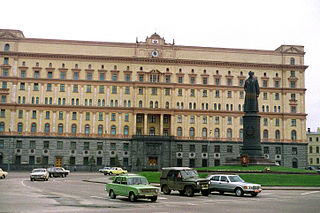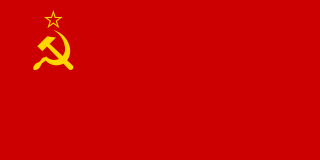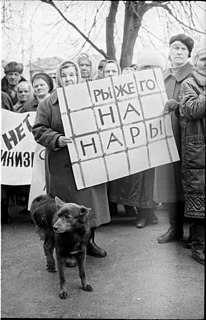In the second economy of the Soviet Union, a tsekhovik (Russian :цеховик,IPA: [t͡sɨxɐˈvʲik] ) was an owner-operator of an illegal, underground tsekh ("factory"). The manufactured goods were distributed via black market. [1] [2]
The second economy in the Soviet Union was the informal sector in the economy of the Soviet Union. The term was suggested by Gregory Grossman in his seminal article, "The Second Economy of the USSR" (1977). Economist Gerard Roland noted that as Grossman anticipated, "the logic of the second economy tended over time to undermine the logic of the command system and to lead to expanding black markets". This prediction was corroborated by the long-term analysis of the economies of Russia and Ukraine (1965–1989) by Treml and Alexeev. To a varying degree, second economy influenced all Eastern Bloc economies.

Russian is an East Slavic language, which is official in the Russian Federation, Belarus, Kazakhstan and Kyrgyzstan, as well as being widely used throughout Eastern Europe, the Baltic states, the Caucasus and Central Asia. It was the de facto language of the Soviet Union until its dissolution on 25 December 1991. Although, nowadays, nearly three decades after the breakup of the Soviet Union, Russian is used in official capacity or in public life in all the post-Soviet nation-states, as well as in Israel and Mongolia, the rise of state-specific varieties of this language tends to be strongly denied in Russia, in line with the Russian World ideology.

A black market, underground economy, or shadow economy is a clandestine market or series of transactions that has some aspect of illegality or is characterized by some form of noncompliant behavior with an institutional set of rules. If the rule defines the set of goods and services whose production and distribution is prohibited by law, non-compliance with the rule constitutes a black market trade since the transaction itself is illegal. Parties engaging in the production or distribution of prohibited goods and services are members of the illegal economy. Examples include the drug trade, prostitution, illegal currency transactions and human trafficking. Violations of the tax code involving income tax evasion constitute membership in the unreported economy.
With the exception of petty handicraftsmanship, any larger scale manufacturing was illegal in late Soviet Union.
The operation of tsekhoviks was based on the widespread scarcity of consumer goods in the Soviet Union produced by the legal planned economy of the country. Tsekhoviks maintained deep connections with both corrupted officials and the criminal world, necessary for the safety and efficiency of the operation. [3]

The industry of the Soviet Union was usually divided into two major categories. Group A was "heavy industry," which included all goods that serve as an input required for the production of some other, final good. Group B was "consumer goods", including food, clothing and shoes, housing, and such heavy-industry products as appliances and fuels that are used by individual consumers. From the early days of the Stalin era, Group A received top priority in economic planning and allocation so as to industrialize the Soviet Union from its previous agricultural economy.
Soviet-type economic planning (STP) is the specific model of centralized economic planning employed by Marxist–Leninist socialist states modeled on the economy of the Soviet Union. Although there was significant variation among these economies, Soviet-type planning and Soviet-type economies refers to the major structural characteristics common to these economies.
Russian organized crime or Russian mafia, sometimes referred to as Bratva, is a collective of various organized crime elements originating in the former Soviet Union. The acronym OPG is Organized Criminal Group, used to refer to any of the Russian mafia groups, sometimes modified with a specific name, e.g. Orekhovskaya OPG. Sometimes the acronym is translated and OCG is used.
A notable criminal case resulted from Operation 'Cartel' carried out by KGB, which uncovered several major illegal furrier factories in Kazakh SSR. It ended in prosecution of some 500 people, with 3 bosses receiving death sentences. [4]
The Soviet fur mafia was a major organized crime uncovered in the Soviet Union in 1970s as a result of Operation 'Cartel' by KGB. It was operating around several "underground" furrier factories in Kazakh SSR. The case ended in prosecution of some 500 people, with 3 top tsekhoviks receiving death sentence.

The KGB, translated in English as Committee for State Security, was the main security agency for the Soviet Union from 1954 until its break-up in 1991. As a direct successor of preceding agencies such as Cheka, NKGB, NKVD and MGB, the committee was attached to the Council of Ministers. It was the chief government agency of "union-republican jurisdiction", acting as internal security, intelligence and secret police. Similar agencies were constituted in each of the republics of the Soviet Union aside from Russia, and consisted of many ministries, state committees and state commissions.
With the beginning of perestroika , which, among other things, allowed private enterprise, many former tsekhoviks suddenly became wealthy, respectable entrepreneurs, known as "new Russians". At the same time the growth of criminal enterprise continued well into the history of modern Russia, [4] the driving force being increased profit via tax evasion and violation of various health, safety, etc., codes.
Perestroika was a political movement for reformation within the Communist Party of the Soviet Union during the 1980s and 1990s and is widely associated with Soviet leader Mikhail Gorbachev and his glasnost policy reform. The literal meaning of perestroika is "restructuring", referring to the restructuring of the Soviet political and economic system.
The New Russians were newly rich business class in post-Soviet Russia. It is perceived as a stereotypical caricature. According to the stereotype, "New Russians" achieved rapid wealth by using criminal methods during Russia's chaotic transition to a market economy.
Tax evasion is the illegal evasion of taxes by individuals, corporations, and trusts. Tax evasion often entails taxpayers deliberately misrepresenting the true state of their affairs to the tax authorities to reduce their tax liability and includes dishonest tax reporting, such as declaring less income, profits or gains than the amounts actually earned, or overstating deductions.







